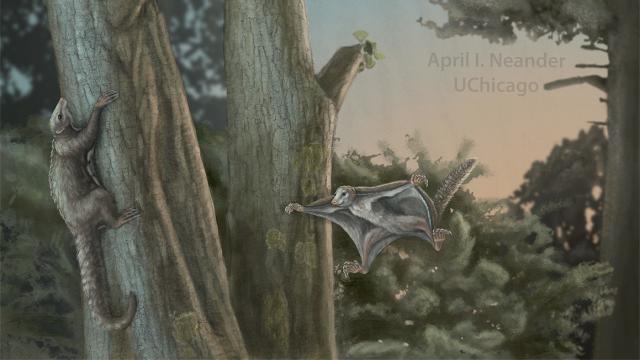The origin of flight remains a perplexing topic in the scientific community, as tends to be the case with any origin story. Flight probably evolved multiple times in different groups. Insects probably started flying over 300 million years ago, and pterosaurs, large flying reptiles, evolved 230 million years ago. Add gliding and the complex origins of mammals into the mix, and the story becomes even more confusing.
Reconstruction by April I. Neander/UChicago
Now, scientists are announcing a new pair of ancient airborne animals, and they aren’t bugs, birds or lizards. They’re mammalian relatives, and, at 160 million years old, they could have taken to the skies tens of millions of years before the last oldest gliding mammalian ancestor. They beat bats by a hundred million years.
The two new species “are the most primitive known gliders in mammal evolution, evolving approximately 100 million years before the earliest known therian gliders,” the group that includes marsupials and placental mammals, according to the pair of papers published today in the journal Nature.
The scientists discovered both of these species in the 160 million-year-old Tiaojishan Formation in China. They named one Maiopatagium furculiferum after the Latin words for “mother” and for those words describing the skin membranes it used for flying and its clavicle, which is similar to a bird’s wishbone. They named the other Vilevolodon diplomylos, after the Latin word for “glider” and Greek words to describe the shape of its teeth.
Underarm skin membranes lining the animals’ sides, called patagium, showed up in closer ultraviolet analysis of both specimens. These features, combined with the specimens’ limb proportions, hinted the researchers towards both species’ gliding abilities. One of the mammal-like creatures, M. furculiferum, had teeth like modern plant-eating bats, while the other, V. diplomylos, had much stranger teeth unlike its contemporaries — it may have been both an omnivore and a herbivore, the scientists write.
You might be wondering why I haven’t called these new creatures, which essentially looked like pillow pet-possums, mammals. While they are mammaliaforms, the researchers call them extinct relatives to modern mammals, rather than direct ancestors. Some think they could be mammals, but recent study of the teeth from another member of this group of animals, called the haramiyids, cast doubt on whether they are truly evolutionary ancestors of mammals or a branch off of the evolutionary tree.
Still, the researchers write that M. furculiferum provides early evidence of a tree-dwelling animal evolving into gliding animals, while V. diplomylos lived a lifestyle only thought to be lived by more modern gliding and flying mammals like flying squirrels.
Evolution does a lot of weird things. But if the weird thing works, it will do it again.
